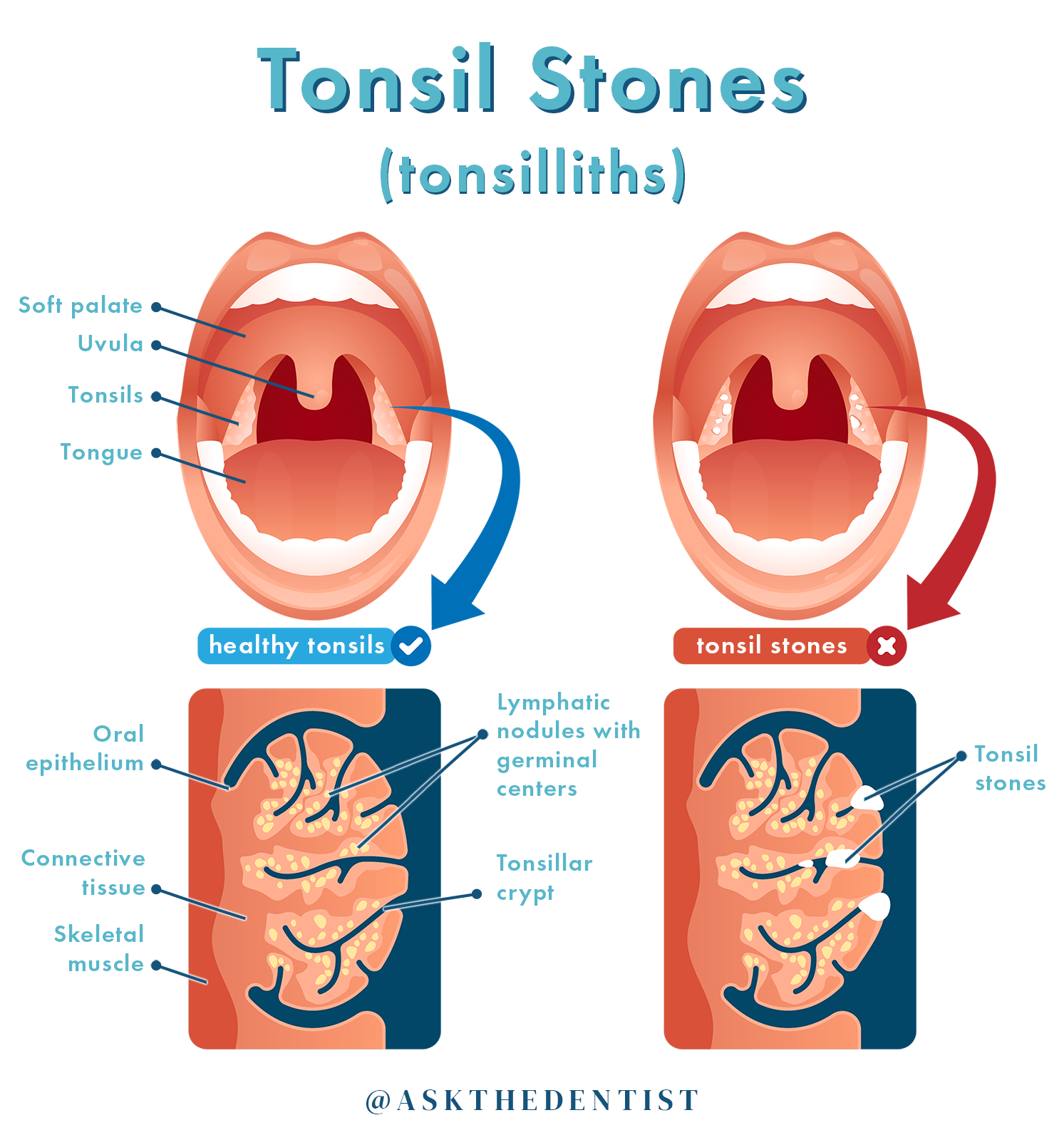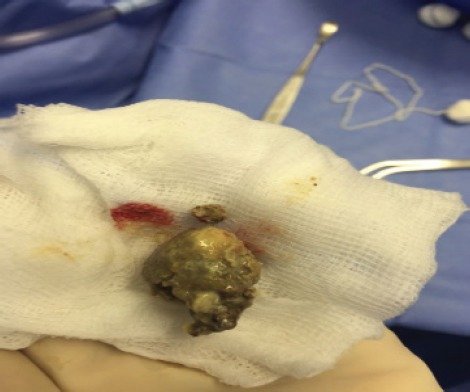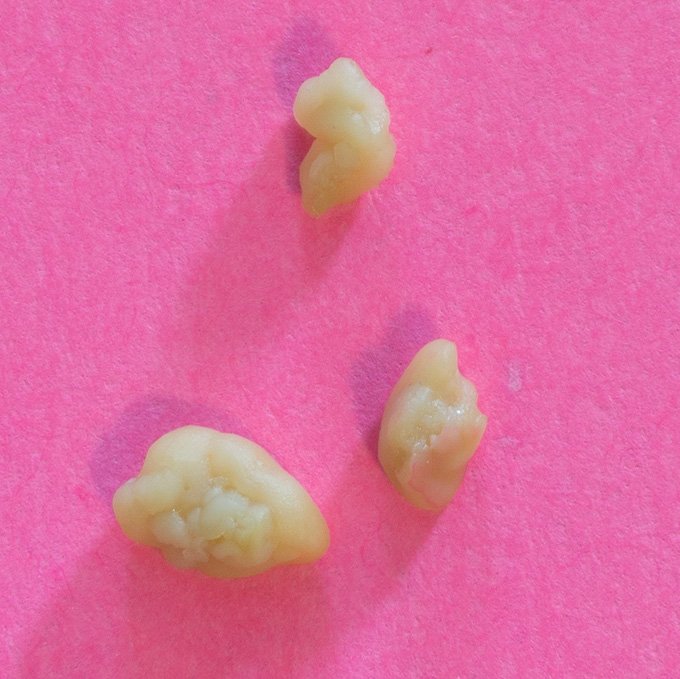What are tonsil stones?
Tonsil stones (aka tonsil calculi or tonsilloliths) are yellowish or white calcifications that develop on the tonsils—the fleshy pads that line the back of the throat. They can be as small as a grain of rice grain or as large as a grape.In general, tonsil stones are caused by an imbalance in the oral microbiome, but specific causes can vary.
Get Dr. B’s Dental Health Tips
Free weekly dental health advice in your inbox, plus 10 Insider Secrets to Dental Care as a free download when you sign up

Causes of Tonsil Stones
Tonsil stones build up in the crypts (crevices) of your tonsils and can result from a number of causes.
Causes of tonsil stones include:
- Poor dental hygiene
- Chronic mouth breathing (during the day or at night)
- Deep crevices (crypts) in the tonsils (where food particles can become lodged)
- Large tonsils
- Chronic tonsillitis (inflammation of the tonsils)
- Hormonal changes (like during pregnancy)
- Too much calcium in the blood without enough vitamins K2 and D3

Tonsil Stone Symptoms
A mild case of tonsil stones may go unnoticed. However, once they make it feel like you constantly have to swallow or cause nasty halitosis (bad breath), tonsil stones can be a major inconvenience.
The most frequently reported symptoms of tonsil stones are chronic bad breath and feeling like you constantly need to swallow. Oth common symptoms of tonsil stones include:
- Visible yellowish or white stone on the tonsils (on one or both sides)
- Sore throat
- Difficulty swallowing
- Ear pain
- Persistent cough
- Swollen tonsils
Tonsil Stones Pictures
References



Tonsil Stones
Tonsil stones often fall out on their own, but, if they’re uncomfortable, you may be able to remove them on your own.
Proceed with caution. Tonsil stone removal can be simple and easy. Unfortunately, some sources recommend home remedies that are not safe, like using tweezers or a toothbrush to dislodge tonsil stones.
To remove tonsil stones at home safely, try the following home remedies:
- Vigorously gargle with warm salt water.
- Use an oral irrigator (water flosser) to gently spray water to dislodge the calcified stone.
- Very gently nudge tonsil stones with a cotton swab.
- Make yourself cough.
Seek medical attention from your dentist or doctor if you experience:
- Tonsils of different sizes
- Blood in your saliva
- Problems swallowing, speaking, or breathing
- Pain, swelling, or lumps in the neck
- Severe pain in your mouth or throat
Tonsil Stone Removal at the Doctor/Dentist
Some stubborn tonsil stones must be removed by a dental professional. If gargling, coughing, and other manual remedies don’t work, you may need to see a healthcare provider about surgical removal of your tonsil stones.
Minor surgical procedures are commonly performed for large or particularly painful tonsil stones. Your tonsil stones can be surgically removed by a dentist, oral surgeon, or an ENT specialist (for severe cases).
Treatment for Recurring Tonsil Stones
For frequent tonsil stone flare-ups, your doctor may prescribe medications such as:
- Anti-inflammatory drugs: Over-the-counter or prescription anti-inflammatories, such as ibuprofen, may help reduce tonsil swelling and make tonsil stones easier to remove. They can also improve discomfort and difficulty swallowing.
- Antibiotics: Antibiotics can wipe out bacteria in your gut, where most of your immune system lives, to reduce the symptoms of a severe tonsil stone flare-up. However, this isn’t a long-term option and should be used infrequently, due to the risk of antibiotic resistance.
Surgical treatments for recurring tonsil stones include:
- Laser tonsil cryptolysis: This procedure involves the use of a laser to get rid of tonsil crypts that can contribute to tonsil stone development. Only local anesthesia is used and most cases require only one visit. There are no major risks or side effects associated with laser tonsil cryptolysis. You should expect to miss no more than 2 days of work while you recover.
- Coblation cryptolysis: Coblation, or the use of radio waves to alter salt solution to charged ions, destroys tonsil crypts without using heat. Like laser cryptolysis, only local anesthesia is used and surgery and recovery are minor. Coblation cryptolysis is a relatively new procedure, introduced in 2012. Its major benefits are the lack of a “burning sensation” caused by laser procedures and no risk of facial burns or damage to the eyes.
- Tonsillotomy: In this tonsil surgery, only the palatine tonsils (where tonsil stones occur) are removed. It is also known as a partial tonsillectomy and requires general anesthesia. However, a tonsillotomy is less invasive than a full tonsillectomy and has a shorter, less painful recovery for both children and adults. Tonsillotomy is equally as effective as a full tonsillectomy — and preferred more by patients — to treat recurring tonsil stones.
- Tonsillectomy: The most drastic surgical option for tonsil stone flare-ups is a tonsillectomy. This surgery involves removing all three types of tonsils (palatine, pharyngeal, and lingual). If your dentist or doctor has identified enlarged adenoids as a trigger for nighttime mouth breathing or sleep-disordered breathing, your adenoids may also be removed during this surgery.
Because they are associated with some risks, surgical options are typically used only if tonsil stones significantly disrupt your life. Surgery for tonsil stones is controversial and should be used as a last resort after other options have been exhausted.
How to Prevent Tonsil Stones
The most effective way to prevent tonsil stones is to maintain a healthy oral microbiome through a healthy diet, good oral hygiene, and addressing dry mouth.
There are several ways to prevent tonsil stones:
- Brush your teeth twice each day and 45 minutes after eating any sugary, acidic, or processed foods/drinks.
- Use a remineralizing toothpaste like RiseWell.
- Scrape your tongue every day.
- Floss every day.
- Eat a diet rich in nutrient-dense foods and low in sugar and processed foods.
- Use oral/dental probiotics if you notice signs of dental problems like bleeding gums (gingivitis) or bad breath.
- See your dentist and dental hygienist at least every 6 months for regular teeth cleanings.
- Avoid alcohol-based and/or antibacterial mouthwash, which are like an antibiotic for the mouth that disrupt the oral microbiome.
- Mouth tape at night if you show any signs of sleep-disordered breathing (such as snoring, waking up in the middle of the night, or dry mouth in the morning).
- Stop smoking, vaping, or using any form of tobacco.
- Don’t abuse alcohol.
- Address chronic tonsillitis or sinus infections with your ENT and/or primary care doctor.
Diagnosing Tonsil Stones
Most tonsil stones are diagnosed by a physical examination by your dentist or doctor. They can often see the white or yellow stones formed on your tonsils, which is a dead giveaway that tonsil stones are to blame.
If you have very deep tonsillar crypts (crevices), your healthcare provider may prescribe imaging like a CT scan or MRI to locate stones. X-rays are unreliable for identifying hidden tonsil stones.
A primary care provider is likely to refer you to an ear, nose, and throat doctor (doctor of otolaryngology) for treatment or to confirm their diagnosis.
FAQs
Are tonsil stones contagious?
Tonsil stones are not contagious. However, you can pass bacteria from your oral microbiome to another person’s by kissing or sharing utensils. Since tonsil stones are related to the health of your oral bacteria, kissing or sharing utensils with someone who has tonsil stones may risk sharing the microbial culprits.
Why do tonsil stones smell so bad?
Tonsil stones smell bad because they are home to anaerobic bacteria. These bacteria create sulfides, which give off a putrid smell.
How long do tonsil stones last?
Tonsil stones may last anywhere from several days to several years. Most tonsil stones clear up in 1-3 weeks on their own. Large stones may remain on the tonsils for many years if not removed by a doctor.
How common are tonsil stones?
Up to 5-6% of adults experience tonsil stones. Factors that increase the commonality of tonsil stones include:
Factors that increase the commonality of tonsil stones include:
- Male gender
- Age over 40
- Hispanic or Caucasian ethnicity
- Poor oral hygiene
- Frequent tonsil or sinus infections
References
- Abdulrhman, A., Albesher, M. B., & Alqabasani, M. A. (2018). A giant tonsillolith. Saudi Medical Journal, 39(4), 412-414. Full text: https://www.ncbi.nlm.nih.gov/pmc/articles/PMC5938656/
- Aragoneses, J. M., Suárez, A., Aragoneses, J., Brugal, V. A., & Fernández-Domínguez, M. (2020). prevalence of palatine tonsilloliths in Dominican patients of varying social classes treated in university clinics. Scientific reports, 10(1), 1-7. Full text: https://www.ncbi.nlm.nih.gov/pmc/articles/PMC6997381/
- Takahashi, A., Sugawara, C., Kudoh, T., Uchida, D., Tamatani, T., Nagai, H., & Miyamoto, Y. (2014). Prevalence and imaging characteristics of palatine tonsilloliths detected by CT in 2,873 consecutive patients. The scientific world journal, 2014. Full text: https://www.ncbi.nlm.nih.gov/pmc/articles/PMC4214167/
- Balaji Babu, B., Avinash Tejasvi, M. L., CK, A. A., & Chittaranjan, B. (2013). Tonsillolith: A panoramic radiograph presentation. Journal of clinical and diagnostic research: JCDR, 7(10), 2378. Full text: https://www.jcdr.net/article_fulltext.asp?id=3530
- Ansai, T., & Takehara, T. (2005). Tonsillolith as a halitosis-inducing factor. British dental journal, 198(5), 263-264. Abstract: https://pubmed.ncbi.nlm.nih.gov/15870743/
- Oda, M., Kito, S., Tanaka, T., Nishida, I., Awano, S., Fujita, Y., … & Kokuryo, S. (2013). Prevalence and imaging characteristics of detectable tonsilloliths on 482 pairs of consecutive CT and panoramic radiographs. BMC Oral Health, 13(1), 1-8. Full text: https://www.ncbi.nlm.nih.gov/pmc/articles/PMC3852777/
- Krespi, Y. P., & Kizhner, V. (2013). Laser tonsil cryptolysis: in-office 500 cases review. American Journal of Otolaryngology, 34(5), 420-424. Abstract: https://pubmed.ncbi.nlm.nih.gov/23583078/
- Chang, C. Y., & Thrasher, R. (2012). Coblation cryptolysis to treat tonsil stones: a retrospective case series. Ear, Nose & Throat Journal, 91(6), 238-254. Abstract: https://pubmed.ncbi.nlm.nih.gov/22711390/
- Smith, S. (2016). Tonsillotomy: An alternative surgical option to total tonsillectomy in children with obstructive sleep apnoea. Australian Family Physician, 45(12), 894. Abstract: https://pubmed.ncbi.nlm.nih.gov/27903040/
- Wong Chung, J. E., van Benthem, P. P. G., & Blom, H. M. (2018). Tonsillotomy versus tonsillectomy in adults suffering from tonsil-related afflictions: a systematic review. Acta Oto-Laryngologica, 138(5), 492-501. Abstract: https://pubmed.ncbi.nlm.nih.gov/29241412/

 Breastfeeding & Jaw Development: How to Prevent Braces
Breastfeeding & Jaw Development: How to Prevent Braces